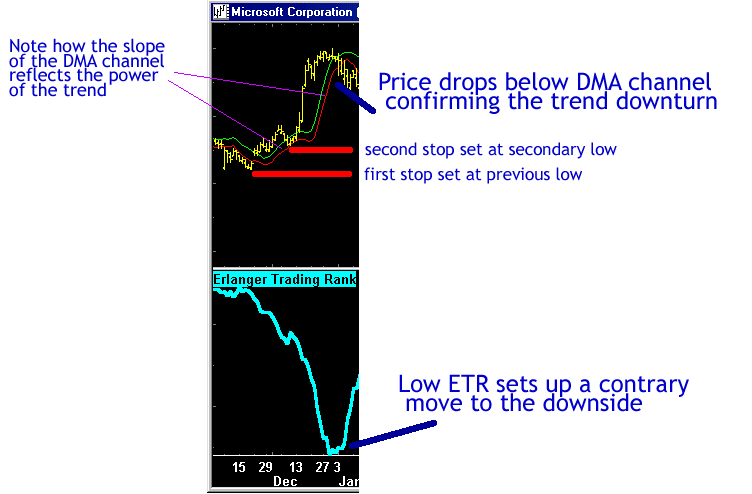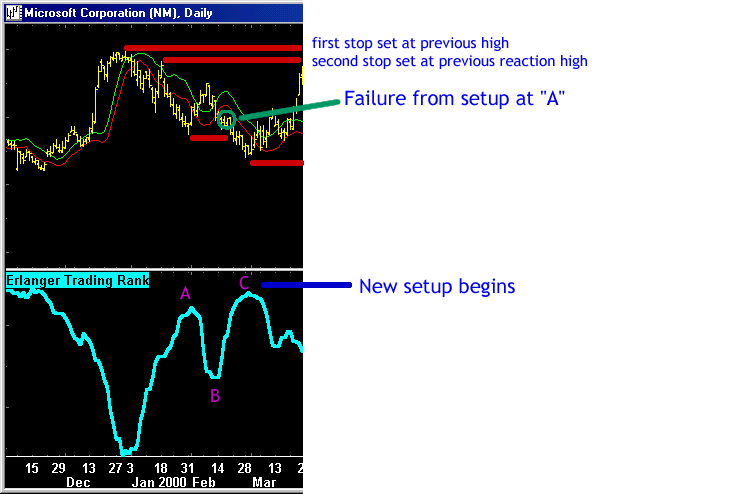|
White Paper
Analysis of Erlanger Data Series:
Displaced Moving Averages
By: Philip B. Erlanger, CMT
IV. Applying DMA to the Erlanger Trading Rank
DMAs by themselves are not intended as buy and sell signals. Rather,
DMAs are best applied as short-term "triggers" and as short-term
trend "monitors" in conjunction with other, independent indicators.
A "trigger" occurs when price moves across one or both DMA lines
- the DMA channel. "Monitor" status occurs when a trend is underway.
For example, if there is an upturn in price, we look for price to
stay above the DMA channel. We are also concerned with the slope
of the channel. The steeper the slope of the DMA channel, the more
powerful the advance phase. This brings us to the heart of the matter.
Stocks generally transit from advance phase to decline phase and
back to advance phase - so on and so on. How the current phase
unfolds can setup the tone of the next phase… if an advance
phase is mediocre, the next decline phase is more likely to be nasty.
If a decline phase in mild, this could setup a stronger advance.
The DMA helps in monitoring the tone of the current advance phase.
The Erlanger Trading Rank (ETR) is a normalized, composite measure
of equity options trading. It is stock specific. The higher the
ETR, the greater the "activity" of puts versus calls. The lower
the ETR, it is the calls that dominate the action. Therefore, the
higher the ETR, the greater are the negative expectations on the
part of options traders. The lower the ETR, the greater are the
positive expectations on the part of options traders. At extremes,
contrary opinion suggests looking for a contrary trend change. The
DMA helps us determine and monitor the progress.
Below is a chart of Microsoft with a DMA channel and ETR plotted:

This chart shows many successful setups, but it also shows setup
failures. The DMA aids in handling both situations.
The following graphic shows the first setup contained in the above
chart. The Erlanger Trading Rank is high, indicating excess negative
expectations. Price has just moved (actually gapped) above the DMA.
Upside follow-through ensues:

The next figure shows where to set stops when a new trade is taken.
As price broke above the DMA channel, a trade could reasonably be
taken there. Set your stop at the previous price low as indicated.
We advise setting a stop here because should price break to a new
low, our premise for a turnaround is proven false by the market,
leaving no justification for staying with the position. Often after
a buy trade is triggered by a move above the DMA channel, some form
of testing occurs. If the lower band of the DMA channel holds, then
raise your stop to the secondary low made on the test, as indicated
in the figure. In this case the upside resumption of the trend was
forceful, resulting in a steep slope of the DMA channel - this steep
slope is an indication of strong upside momentum. However, the ETR
also changed significantly, and eventually dropped to a very low
measure. This was a setup for a contrary trend change to the downside,
which did occur:

The next figure shows a failure from the setup starting with point
"A". The ETR had risen to reasonably high levels, and price turned
up through the DMA channel. The subsequent test failed to hold (blue
circle), and price ultimately sank to lower lows. Not every setup
is going to work, but the ETR and DMA channel make it easier to
manage these failures by clearly showing when price fails to measure
up. In this case, the ETR had quickly eroded during this brief upturn,
returning to a low level at point "B".
This failure did however contribute to the next setup at point
"C" where the ETR rose to higher levels. The next upturn of price
through the DMA channel tested successfully, and resulted in a meaningful
advance phase:

In the next figure, point "D" is a clear setup for a decline phase.
Despite a pending judgement concerning a potential breakup, the
ETR showed excess call activity versus puts. Price quickly fell
below the DMA trigger. The decline phase was large and experienced
5 successful tests of the trend in the form of moves to but not
above the DMA channel. Put activity grew at point "E", setting up
for the next advance phase, but this setup was early as price was
unable to advance until after point "F".

The figure below shows another instance when the DMA channel made
clear when a setup and trigger fails. Price rose above the DMA channel
after the ETR setup at point "H". The advance phase was weak, however,
and price flattened out while slipping below the DMA channel (see
blue box). The slope of the DMA channel and the price action made
clear the failure of MSFT to accomplish the anticipated advance.

II. Definitions
III. Applying DMA's to Erlanger 2000 charts
V. Conclusion
Back to Start of White Paper
|





